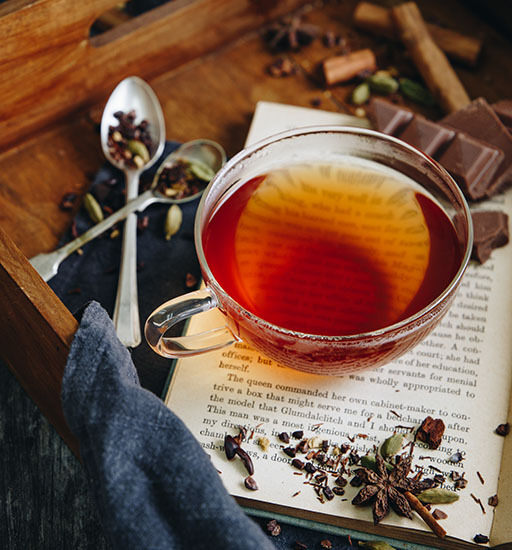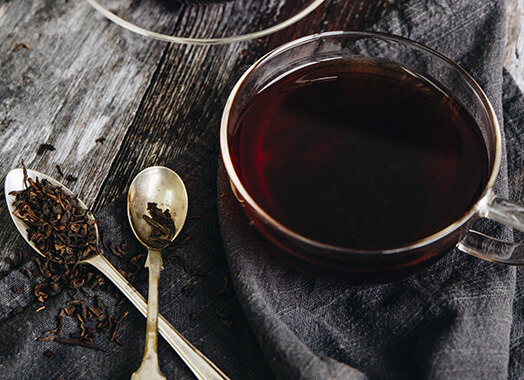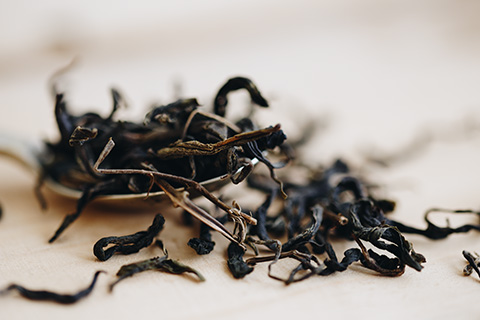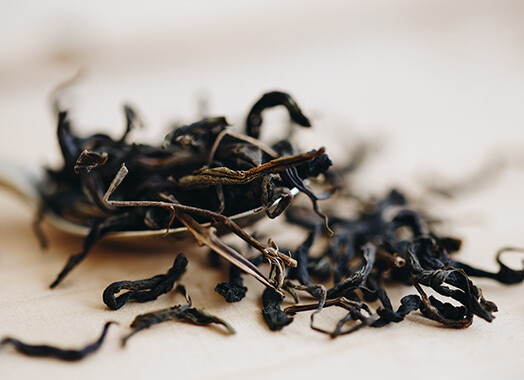
Baffled by black tea? Puzzled by puerh?
Never fear: we’ve put together a handy guide to the different types of tea.
Black Tea
Black teas is fully oxidised, meaning that molecules in the tea react with oxygen to give the leaves a rich, robust flavor. Aside from that, black tea can vary hugely in taste: a delicate Darjeeling could hardly be more different from a sweet, malty Assam or a smoky Lapsang Souchong.
Many of our black teas are flavored with fruit, spices or even flower petals, or infused with essential oils to complement the flavor of the tea. Their natural depth and richness makes them the perfect base for a wide range of different flavor combinations – why not get exploring?
How is it Produced?
Black teas are unique for being the only completely oxidised type of tea, giving them a distinctively full body and rich, malty taste.

PICKING
More mature leaves are usually chosen for black tea.

WITHERING
The leaves are laid out on racks to dry for several hours.

ROLLING
Rolling the leaves in large drums triggers oxidation.

OXIDATION
Enzymes in the leaves react with oxygen, changing their taste.

DRYING
Finally, the leaves are dried, sorted and packed.
How To Brew
Black teas is more robust than other tea types, so don't hold back: we recommend brewing in freshly boiled water for 3–5 minutes. An exception is First Flush Darjeeling, which is unusually delicate for black tea and should be brewed at around 194°F for no longer than 3 or 4 minutes.
1 teaspoon
194°F
3-4 minutes
Green Tea
The core difference between green and black tea is oxidation. While black tea is oxidised to change its flavor and appearance, green tea is heated to stop oxidation – preserving that fresh taste and green colour that makes it famous.
Many of the best green teas are found in Japan or China, whose different methods of steaming and firing to stop oxidation can have a big effect on the final cup. A fired green tea like Marrakech Mint tends to have a slightly nutty or smoky flavor, while steamed Japanese Gyokuro has a peas-in-a-pod freshness. We've got creative with many of our green teas – why not try a flavored blend like Pineapple & Ginger Punch?
How is it Produced?
Unlike black tea, green tea is heated before oxidation can take place – preserving its delicate, refreshing taste.

PICKING
The delicate bud and top two leaves are best for green tea.

WITHERING
The leaves are laid out on racks to dry for 1–3 hours.

HEATING
To prevent oxidation, the leaves are fired or steamed and "fixed".

ROLLING
Most green teas are rolled to release their aromatic oils.

DRYING
Finally, the leaves are dried, sorted and packed.
How To Brew
green tea is more delicate than black tea, and should never be brewed with boiling water: the heat extracts tannins, giving your tea a bitter, astringent flavor. Instead we recommend using water off the boil (around 176°F) – leave the kettle after boiling for five minutes, then pour and infuse for 2–3 minutes.
1 teaspoon
176°F
2-3 minutes
Fruit & Herbal Infusions
Our fruit and herbal infusions don't technically contain tea: instead, they're blended from fruit, herbs, spices and flowers. This means that all of our infusions are naturally caffeine-free.
There's an extraordinary range of flavors possible in a fruit and herbal infusion, from the natural sweetness of camomile flowers to bright, tart berries and hibiscus flowers. Yerba mate is a South American herb with a natural caffeine buzz; you'll find it in one of our wellness teas - Boost.

Rooibos (“Red Bush”)
Rooibos – a bush grown on the mountains of South Africa – has long been harvested to create a herbal infusion, with a smooth, treacle-toned taste. Seventeenth-century Dutch settlers soon developed a taste for the drink as a handy substitute for tea, but local bushmen had already passed down the secret of rooibos for generations.
The leaves undergo a similar process to black tea, being oxidised for a distinctive reddish-brown colour and malty flavor. Occasionally, rooibos is produced in a more similar manner to green tea: you'll find this unusual "green" rooibos in our Rainforest Rooibos blend.
How To Brew
As our fruit and herbal infusions don't contain tea, there's no tannic bitterness associated with overbrewing – how you infuse is largely up to you! We recommend using double quantities (around 2tsp per cup) and freshly drawn and boiled water, then brewing for at least 3 minutes to get the most flavor possible out of your cup.
2 teaspoons
212°F
At least 3 minutes
Speciality Teas
Tea production is a centuries-old art, and throughout its long history tea growers have experimented with different techniques – from firing and steaming to more unusual methods like the steam oxidation used to produce yellow tea.
Oolong
Partially oxidised and laboriously hand-rolled, oolong tea ranges from distinctive high-grown varieties to lighter, creamy oolongs.
How to Brew
Add one teaspoon (around 2g) of loose leaf tea per cup and freshly drawn and boiled water, left for a minute or two to cool to around 194°F. Brew for 3 minutes.
White Tea
The least processed form of tea, white tea is simply left to dry for a light, subtly sweet and delicate flavor.
How to Brew
Add two teaspoons (around 4g) of loose leaf tea per cup and use water off the boil (around 176°F) – leave the kettle after boiling for five minutes, then pour and infuse for 2–3 minutes.

Puerh
Famous for its unique processing and taste, puerh is fermented – sometimes for decades – to give it a rich, aromatic flavor.
How to Brew
Add one teaspoon (around 2g) of loose leaf tea per cup. Just cover the leaves with freshly boiled water, then immediately pour away the water: this "wakes up" the leaves for a fresher flavor. Then brew the puerh in freshly drawn water for up to 2 minutes.

Yellow Tea
Smooth, nutty yellow tea is the rarest type of tea in the world, produced only in minute quantities through a laborious process of piling and carefully monitoring the leaves.
How to Brew
Add two teaspoons (around 4g) per cup and always use freshly drawn and boiled water. Allow to brew for 3–5 minutes according to taste.

















